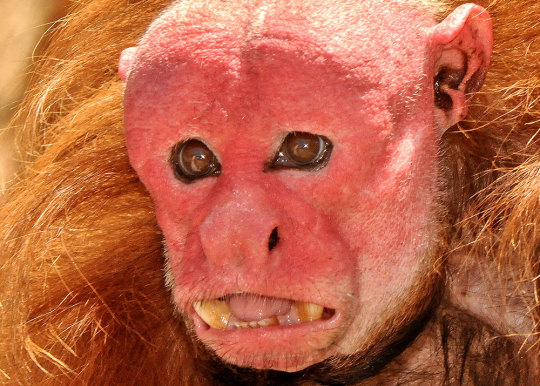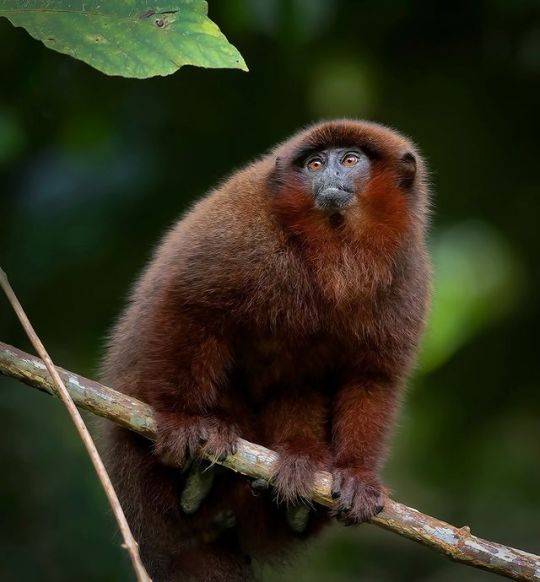#Pitheciidae
Photo

Golden-faced Saki
#golden faced saki#saki#monkey#Pithecia chrysocephala#Primates#Haplorhini#Simiiformes#Pitheciidae#Pithecia#upl
62 notes
·
View notes
Photo

A bald uakari (Cacajao calvus) in Los Angeles Zoo
by Tad Motoyama
#bald uakari#uakari#monkeys#cacajao calvus#cacajao#pitheciidae#simiiformes#haplorhini#primates#mammalia#captive animal#la zoo
17 notes
·
View notes
Text
A Mittermeier's Tapajos saki, A primate from the Amazon forest

The Mittermeier’s Tapajos Saki (Pithecia mittermeieri):
2 notes
·
View notes
Photo

White-faced saki (Pithecia pithecia) in French Guiana
Michel Giraud-Audine
248 notes
·
View notes
Photo

WHITE FACED SAKI
Pithecia pithecia
©Laura Quick
The white-faced saki, called the Guianan saki and the golden-faced saki, is a species of the New World monkey. They can be found in Brazil, French Guiana, Guyana, Suriname and Venezuela. They eat a mixed diet of seeds, fruits, leaves, honey, flowers, insects, and small mammals and birds and typically ingest seeds and plants that are high in lipid composition. Although they are arboreal creatures and are specialists of swinging from tree to tree (brachiation), they are also terrestrial when foraging. White-faced sakis typically live around 14 years in their natural habitat and have been recorded to live up to 36 years in captivity.
Other New World Monkeys:
Black Howler Monkey
Black Headed Spider Monkey
Black Spider Monkey - with blue eyes
#white faced saki#golden faced saki#guinian saki#monkey#new world#platyrrhine#pitheciapithecia#©lauraquick#africa#leas concern#glaza#lazoo#los angeles zoo and botanical gardens#los angeles zoo#haplorhini#mammal#pitheciidae#sexually dimorphic#sexually dichromic#omnivore#quadrapedal#arboreal#herbivore
7 notes
·
View notes
Text
Just in case you weren’t already aware
the following list shows where the various monkey families (bolded) are placed in the classification of living (extant) primates
ORDER PRIMATES
Suborder Strepsirrhini: lemurs, lorises, and galagos
Suborder Haplorhini: tarsiers, monkeys, and apes
Infraorder Tarsiiformes
Infraorder Simiiformes: simians
Family Tarsiidae: tarsiers
Parvorder Platyrrhini: New World monkeys
Parvorder Catarrhini
Family Callitrichidae: marmosets and tamarins (42 species)
Family Cebidae: capuchins and squirrel monkeys (14 species)
Family Aotidae: night monkeys (11 species)
Family Pitheciidae: titis, sakis, and uakaris (41 species)
Family Atelidae: howler, spider, and woolly monkeys (24 species)
Superfamily Cercopithecoidea
Superfamily Hominoidea: apes
Family Cercopithecidae: Old World monkeys (135 species)
Family Hylobatidae: gibbons ("lesser apes") (17 species)
Family Hominidae: great apes (including humans, gorillas, chimpanzees, and orangutans) (8 species)
5 notes
·
View notes
Text

10/2/20
0 notes
Photo

Hi all,
Today I’ll be talking about the first field study of one member of Pitheciidae, the titi monkey.
The first field study of titi monkeys appears to have been conducted in 1966 by William M. Mason, now a professor emeritus at the University of California. At the time, few field studies had been conducted on any South American primate; the study lasted eleven months, and took place in eastern Colombia. He focused on Callicebus moloch, the dusky titi monkey. This decision was made, in part, because Dr. Mason was interested in primate species that lived in small family groups. He completed a population census across three groves of forest, and also described the social behavior of the subjects (of which there were 28) in great detail (Mason 1966).
References
Mason W. 1966. Social organization of the South American monkey, Callicebus moloch: a preliminary report. Tulane Studies in Zoology. 13(1):24-28.
0 notes
Text

Brown Titi Monkey
#brown titi monkey#monkey#Plecturocebus brunneus#Primates#Haplorhini#Simiiformes#Pitheciidae#Plecturocebus#upl
8 notes
·
View notes
Photo

Today, I’ll focus on a particular member of the Pitheciidae family: the uakari.
There are four recognized subspecies, which can be found in Brazil, Peru, Colombia, and Venezuela (Gron 2008). Like other members of Pitheciidae, they are tropical rainforest dwellers and have a dental formula of 2:1:3:3/2:1:3:3. Specifically, they appear to prefer flooded areas that are in proximity to large water sources (Gron 2008). Primarily frugivores, they may also feed on leaves, seeds, and insects (Felton-Church 2001). It has been suggested that their distinctive red faces are the result of sexual selection (Mayor et al. 2015).
Interesting fact: the uakari monkey also has an unusually short tail. This can be seen in the above picture.
Felton-Church, A. Cacajao calvus red uakari [Internet]. U-M Ecology and Evolutionary Biology: University of Michigan; [cited 2018 Jan 16]. Available from: http://animaldiversity.org/accounts/cacajao_calvus/
Gron, KJ. Uakari Cacajao [Internet]. Primate Info Net: University of Wisconsin-Madison; [cited 2018 Jan 16]. Available from: http://pin.primate.wisc.edu/factsheets/entry/uakari
Mayor P, Mamani J, Montes D, González-Crespo C, Sebastián M, Bowler M. 2015. Proximate causes of the red face of the bald uakari monkey (Cacajao calvus). R Soc Open Sci. 2(7):150145.
0 notes